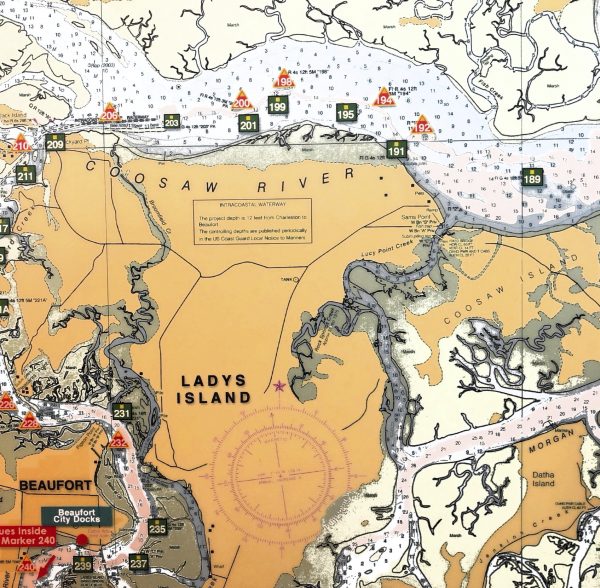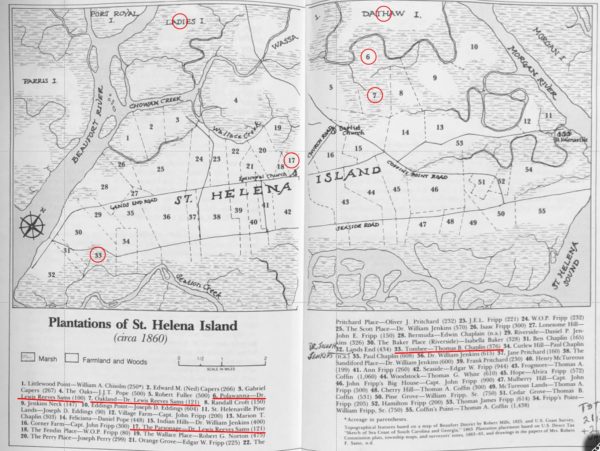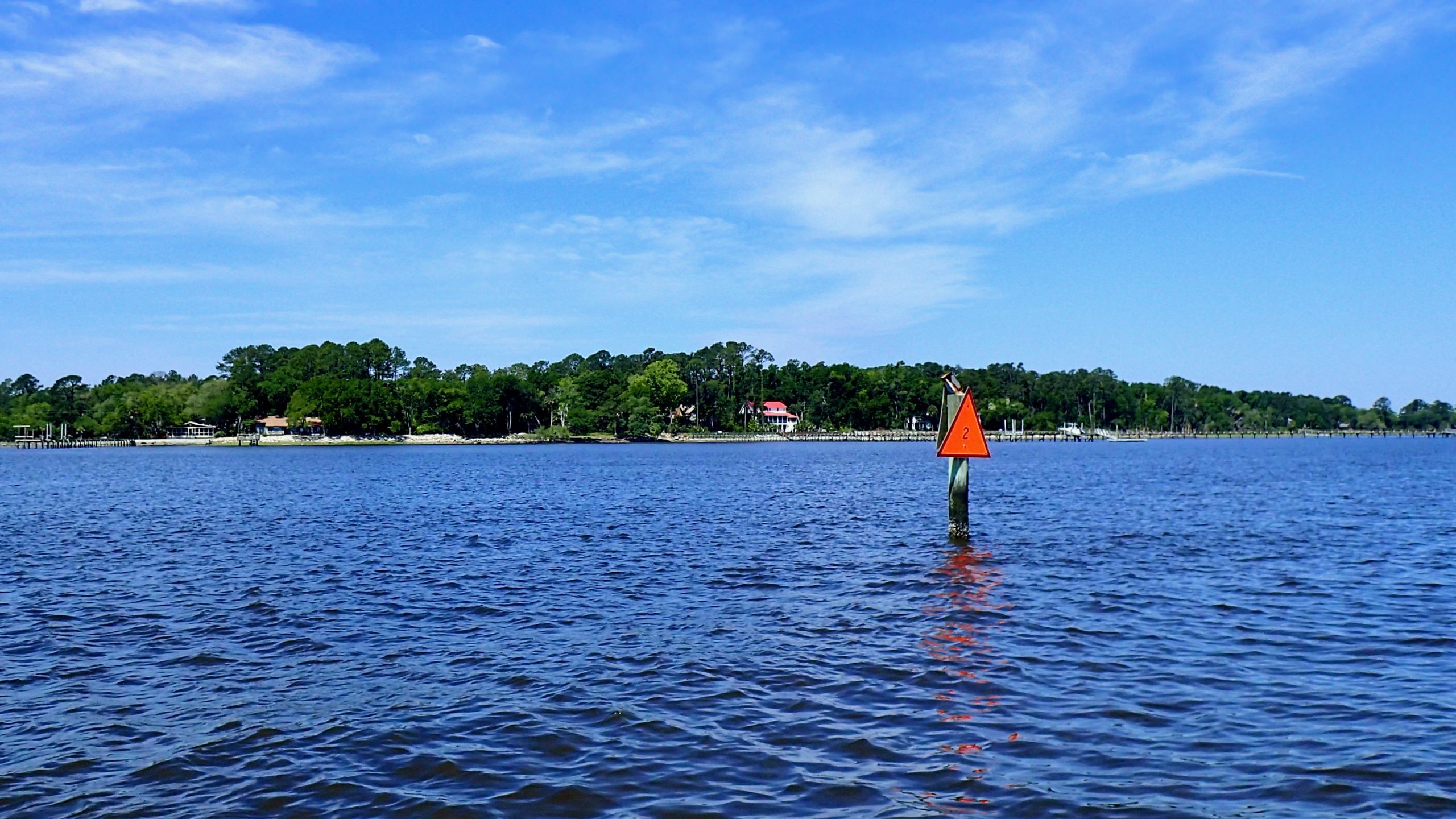Featured photo above is looking west at Sams Point on Ladys Island, S.C. Marker “Red 2” is near the entrance to Lucy Point Creek. Several Sams had plantations in this area. (photo by Bill Riski, April 28, 2020)
Land, glorious land
For centuries the ultimate enabler of an individual’s wealth was land ownership. This was certainly true in the Lowcountry, as rice, lumber, indigo, cattle, and cotton crops created tensions over land. Once the Yemassee Indian Wars ended in the 18th Century, it was much safer to grow rice down our way but inland. By the mid-1700s, the cash crop for the sea islands had arrived in the form of indigo, thanks to Miss Eliza Lucas Pinckney and her neighbor Andre DeVeaux. One of the early and successful indigo plantation owners on a sea island was Robert Sams (~1706 – 1760), father of “our” William Sams (1741 – 1798). Robert was a planter up on Wadmalaw Island. As the American Revolution took a toll on the sale of indigo dye cakes to the British, a new sea island-compatible crop was arriving. Sea island cotton’s exceptional quality and world events in France and England drove Europe’s demand. It was first grown commercially on Hilton Head in 1795, and by 1810 nearly all the suitable cotton land in our area was spoken for. This brings us on a fast trip to the Datha Island plantation brothers, Lewis Reeve Sams (1784 – 1856) and Berners Barnwell Sams (1787 – 1855). They inherited Datha Island from their father and mother once they came of age, in 1805 and 1808, respectively. LR Sams had Datha Point plantation on the north, and BB Sams had Datha Inlet plantation on the south. They started with about 500-acre plantations as the sea island cotton boom hit its stride.
As Dr. Rowland tells us in his first volume of The History of Beaufort County, South Carolina (1514 – 1861) by 1850:
Dr. Berners Barnwell Sams had 2,097 acres and 174 enslaved people on Datha and Lady’s Island…His brother Lewis Reeve Sams had 1,467 acres and 166 enslaved people on adjoining property…
It wasn’t Datha alone that afforded the brothers, and their children, the luxury of elegant homes in Beaufort. It was the totality of their holdings.
Search for Plantations
Determining which person owned which plantation in the antebellum era is not easy. Ownership ebbed and flowed as owners married, children came along, fortunes rose and fell, etc. One usually reliable source is federal census records. But they don’t help much here. Census records report information per person, not per location. So though a census record might tell us how many acres of land someone had, it did not break the number down further. In other words, Dr. BB Sams had 2,097 acres in 1850, recorded in Beaufort District. The Census records do not tell us about Datha or Lady’s Islands, or other Beaufort District tracts. Second, I know of at least one example in the Sams family of a plantation “owner” who leased his land from a relative. Someday, I hope someone will do for the rest of Beaufort what Theodore Rosengarten did for plantations on St. Helena Island. I would love to have a map of plantations owned by the Sams all over Beaufort District, created using sources like U.S. Direct Tax Commission plats, township maps, surveyor’s notes, etc. For today, I’ll rely on the unpublished manuscript by Conway Whittle Sams (1864 – 1935), grandson of Dr. BB Sams and son of Maj Horace Hann Sams (1829 – 1865). His manuscript is primarily a compendium of oral history, so I can’t be sure of all the details.
Beyond Datha with Dr. Berners Barnwell Sams & Sons
Census and other records tell us that BB Sams had nine sons that reached adulthood during his lifetime. By 1850, seven of his sons were adults and old enough to be plantation owners, but were they? Based on CW Sams memoir and a few other sources, here’s what I’ve discovered.
Dr. Berners Barnwell Sams (1787 – 1855) had many plantations on Ladys Island. Across the river from Beaufort was The Bluff. I believe several miles north on the Coosaw River was Laurel Hill. Along the north side of Ladys Island were several other plantations: Bergamot, Black’s Point, and Bolus Point. There may have been a Sams Point plantation on Ladys Island; it is still identified on nautical charts today. However, my crack source (Joe Roney) is trying to track down a reference for this rumor. Dr. BB Sams purchased several of these plantations to give to particular sons. I don’t know if these other plantations are counted in the 2,097 acres mentioned earlier, but they might be. Here’s what CW Sams reveals, starting with Dr. BB Sams’ oldest son.

Berners Bainbridge Sams (1814 – 1850) was given Black’s Point on Lady’s Island by his father. Dr. BB Sams bought it from the Talbirds, Ting Sams Colquhoun’s ancestors on her mother’s side.
Dr. Melvin Melius Sams, M.D. (1815 – 1900) was given Oakland plantation on St Helena Island after Dr. BB Sams purchased it from his nephew, Dr. Lewis Reeve Sams, Jr. Dr. MM Sams is mentioned more than any other Sams in Rosengarten’s book. He was well-liked by planter Thomas B. Chaplin.
Dr. Donald Decatur Sams, M.D. (1820 – 1898) was given Bolus Point plantation on Lady’s Island by his father. And here is another twist. After Dr. DD Sams got his medical degree, he may have managed his plantation for a short while, but he spent nearly all his life in the medical profession up in Charleston. His brother Franklin ran his plantation for him.
Franklin Fripp Sams (1824 – 1885) was given the Bergamot plantation on Lady’s Island by his father. He also managed his brother Dr. MM Sams’ Bolus Point plantation, and Datha Inlet plantation right after his father died.
Rev. James Julius Sams (1826 – 1918) inherited Datha Inlet, along with his brothers Horace Hann Sams and Charles Clement Sams, upon Dr. BB Sams’s death in 1855. JJ Sams was a practicing minister in St. John’s Berkeley Parish at Black Oak Church. And HH Sams was a teacher in Beaufort. In stepped Franklin again; CC Sams was still a bit young. From 1855 to 1856, FF Sams managed Datha Inlet. HH Sams then stepped in and was the active plantation owner with help from CC Sams from 1856 to 1860. But both of them were about to join the Confederate States of America forces as the war began. I know Rev JJ Sams eventually settled in Baltimore about 1878. However, the information we have at the Dataw Historic Foundation reveals he left the area in 1854, married in Virginia in 1859, continued his ministry and further studies at William and Mary College in Virginia, then moved to Maryland. Rev. JJ Sams only returned to South Carolina late in the Civil War to help his brother Maj Horace Hann Sams when Horace fell deathly ill. He may never have returned to Datha after leaving in 1854 at the age of 28.
Dr. Robert Randolph Sams, D.D.S. (1827 – 1910) was given or inherited The Bluff plantation on Lady’s Island by his father. Dr. RR Sams is one of the few Sams to return to Beaufort soon after the Civil War ended, and stayed. He placed ads in local newspapers advertising his dental practice and even tried farming on Datha Island. However he never regained ownership of any plantation land. Sometime after 1905 he did gain legal possession of the Sams Family Cemetery, though it is now considered “heir’s property” of the Sams family.
Major Horace Hann Sams, CSA (1829 – 1865) inherited Datha Inlet, along with his brothers James Julius Sams and Charles Clement Sams, upon Dr. BB Sams death in 1855. As mentioned above, he was the active plantation owner, with help from CC Sams, from 1856 to 1861. HH Sams’ will, dated November 1861, also states:
My real estate thus disposed of consists of one lot in the town of Beaufort, District and State aforesaid, and of one plantation on the Island of Datha, and one-third of an undivided tract of Pine Barren of 100 acres, and a life interest in a tract of Fine Barren of 30 acres on Ladies Island, in the District and State aforesaid; and also a “right of way,” through the plantation of Dr. R. R. Sams, and through the plantation of B. F. Capers, from the town of Beaufort to Datha.
Rev. Barnwell Bonum Sams, Sr. (1835 – 1903) does not appear to have ever been a plantation owner. He may have been away at school when Beaufort was evacuated in November of 1861. We know he was in the Barnwell, S.C. area during the Civil War. In 1864, church records show he was the Rector of the Church of the Holy Apostles, Barnwell, S.C., and Missionary to Blackville.
Charles Clement Sams (1837 – 1865) has been mentioned a few times already. Just before the Civil War, he appears to be the owner of his father’s Laurel Hill plantation on Lady’s Island.
Beyond Datha with Lewis Reeve Sams & Sons
Lewis Reeve Sams had six sons who reached adulthood. But I know much less about him than I do about his younger brother Dr. BB Sams because few historical records or journals exist for him. As was mentioned earlier, I know he had about 1,000 acres of cultivated land beyond his Datha Point plantation. LR Sams is mentioned in the diary excerpts that his granddaughter Sarah Graham (Sams) Sams wrote during her time in Barnwell in the war years. She mostly talks about the Barnwell area and neighbors, though she does mention the comings and goings of her father, Dr. LR Sams, Jr. However, nothing is said about her grandfather or father’s lives before the war in the excerpt we have seen.

Dr. Lewis Reeve Sams, Jr. (1810 – 1888) had plantations on St Helena Island, which are addressed in the Rosengarten book. Dr. LR Sams lived in the now extinct town of St. Helena Village and had three plantations. One was on Polawanna. The other two, Oakland and The Parsonage, were on St. Helena Island. These three plantations totaled about 340 acres. Oakland is the plantation mentioned above that Dr. BB Sams bought and gave to his son, Dr. MM Sams. You heard a lot about Dr. LR Sams, Jr. in an earlier article. He’s the one who relocated with much of his family to Texas after the war.
Miles Brewton Sams (1811 – 1894) is listed as a planter in the Federal Census of 1860. I know nothing about his plantation.
I do not know if these sons were planters: Stanhope Augustus Sams (1820 – 1899), Rev. Marion Washington Sams, Sr. (1822 – 1899), or Dr. Richard Fuller Sams, M.D. (1838 – 1878).
Thomas Fuller Sams (1842 – 1881) was away at school up north when the Civil War started. He likely was too young to have been a plantation owner.
And then the Civil War arrived
All these plantations were lost once the Civil War came to the Beaufort area. As best I can tell, family members repurchased none of the Sams plantations in whole or in part after the war. For the very few Sams who even came back to Beaufort, it was a time of great despair. Conway Whittle Sams was much too young to remember any of this first hand. But his Aunt Bet (Elizabeth E. Sams 1831 – 1906) lived through it all and scribed her memoir on March 18th, 1905. She describes an awful few years, calling it “a time of starvation.” We know things gradually got better, but here’s a very poignant line from her memoir when speaking of her brother, Dr. Robert Randolph Sams:
Randolph made an unsuccessful attempt to cultivate Datha, then owned by a Mr. Woods and Dr. Winslow, purchasers under the tax sale. Randolph said that he and his family lived on potatoe (sic) peelings.
Closure
The dispersion of old Beaufortonians due to the Civil War is fascinating. Why did one arm of the family sail to TX while another went to GA and another to VA? In any case, it’s clear why very few returned to Beaufort. The Federal government shut the door. The Direct Tax Act of August 1861 led to foreclosures on their homes and land in 1863. However, that was not the end of it. Thirty years later, the Federal Government compensated some South Carolinian heirs to settle claims against the earlier foreclosures. By then, nearly all of the old Beaufortonians were gone. In this article, you can read which Sams heirs received compensation per the U.S. Court of Claims decision.
Sources
Porcher, Richard D. – The Story of Sea Island Cotton, 2005
Rosengarten, Theodore –Tombee: Portrait of a Cotton Planter, 1986
Rowland, Lawrence S.; Moore, Alexander; Rogers Jr., George C. – The History of Beaufort County, South Carolina, Volume I, 1514 – 1861, 1996
- Chapter 9 Indigo Culture, 1750 – 1775
- Chapter 15 Introduction of Sea Island Cotton to the Beaufort District, 1790 – 1829
Rowland, Lawrence S.; Wise, Stephen R.; Spieler, Gerhard – The History of Beaufort County, South Carolina, Volume 2, Rebellion, Reconstruction, and Redemption, 1861 – 1893, 2015
- Chapter 7 Emancipation
Sams, Conway Whittle – History of the Sams and Whittle Families, unpublished, circa 1925
Sams, Sarah Graham Sams – Diary from Barnwell Court House, unpublished, 1865
#52Sams-in-52Weeks


